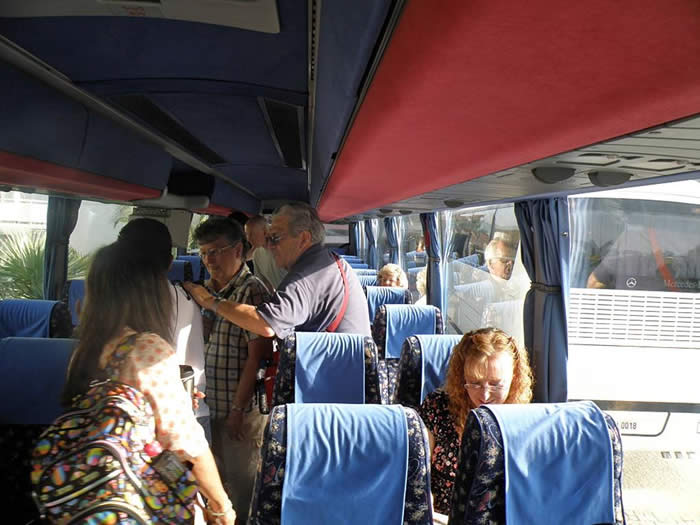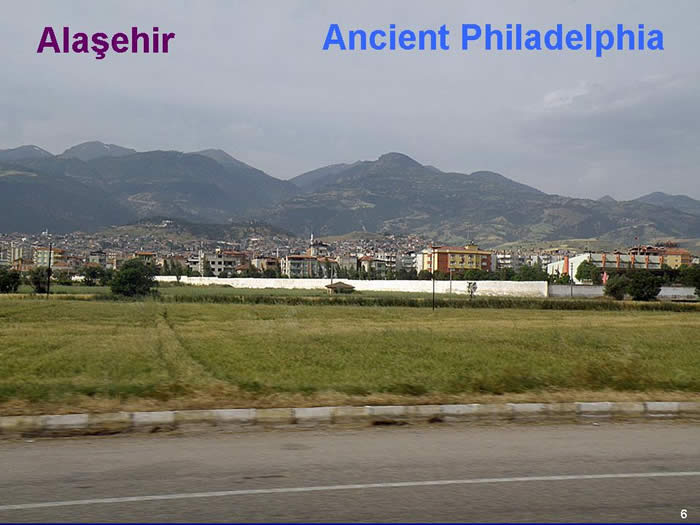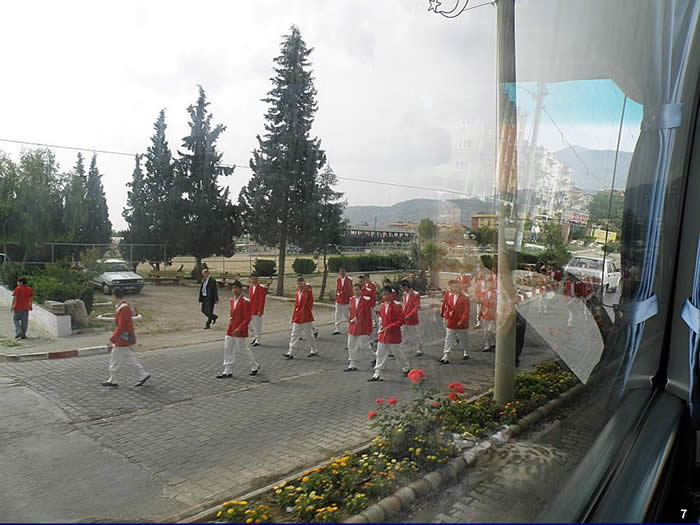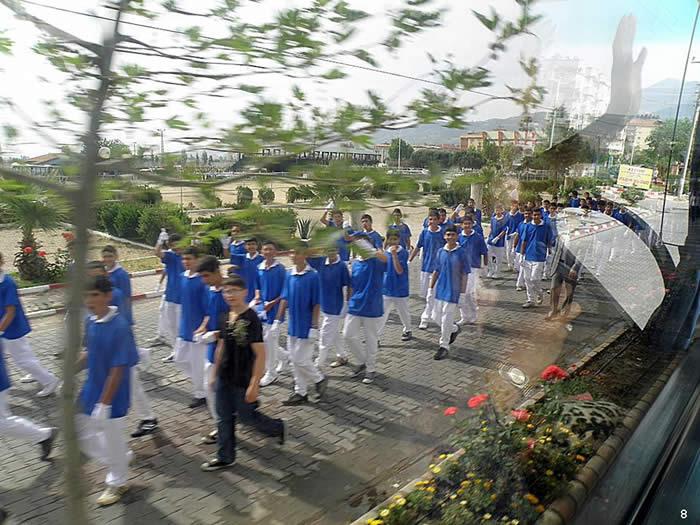
2009 Holy Land Tour - Turkey
Part 7 - Philadelphia
Click on Photos, Maps and Charts for Larger Version
For the past several weeks, I have been telling you about our recent trip to the nation of Turkey. The past two weeks, I have taken you to the Lycus Valley, where we find 3 biblical cities. Laodicea, the last of the seven cities of Revelation 2 & 3. Colossae, which is yet to be excavated. And last week, we spent our time in the city of Hierapolis.
Philadelphia
 The next morning we leave the Lycus Valley and head northwest to the next place on our itinerary, the biblical city of Sardis. But our guide, Seyhun, had some “candy” to give us that day. “Candy” means he takes us to a place not on our itinerary – something extra.
The next morning we leave the Lycus Valley and head northwest to the next place on our itinerary, the biblical city of Sardis. But our guide, Seyhun, had some “candy” to give us that day. “Candy” means he takes us to a place not on our itinerary – something extra.
We pulled off the highway toward the mountains. We drove through the small city of Alaşehir – with a population of almost 50,000. Alaşehir is the modern name of the ancient city of Philadelphia. You may remember when we were in Cappadocia, there was a city named Nevşehir, and I mentioned that the word Şehir means, “city.” In that case, Nevşehir means, New City.
Şehir is again part of the modern city of Philadelphia. And Alaşehir means, Allah’s City, or “city of god.”

 It turns out that this day was an important day in Turkey. This was May 19th, and is called the Turkish Youth and Sports Day, in commemoration of Turkey’s battle of independence. Mustafa Kemal Attaturk, the father of modern Turkey, began the battle for independence on May 19, 1919. They have made it a Youth and Sports Day to remind the children that because of this battle, they now are free.
It turns out that this day was an important day in Turkey. This was May 19th, and is called the Turkish Youth and Sports Day, in commemoration of Turkey’s battle of independence. Mustafa Kemal Attaturk, the father of modern Turkey, began the battle for independence on May 19, 1919. They have made it a Youth and Sports Day to remind the children that because of this battle, they now are free.
We were going down the street of Alaşehir, and marching in the opposite direction was a parade of youths celebrating the day. I took a couple quick photos while we were moving.
We had not planned to go to either Philadelphia or Thyatira, because there are very few ruins at either, and none from the first century. But I think many in our group who had come to Turkey for the first time were very glad to be able to visit one more of the 7 cities of Revelation.
Actually, during the Roman era, there were a number of cities whose names became Philadelphia. Can you remember what other biblical city was given that name by the Romans? Here is a map from my Bible software. Do you see Philadelphia? What was its name – it is the same as it is called today. It is the capital city of the nation of Jordan – Amman.
Philadelphia in Asia Minor was situated in a strategic place on the main route from Rome to the east. Because of that, I have read some documents referring to Philadelphia as the “Gateway to the East.” The city has also been referred to as “The Little Athens.” It was called that because of the many temples in the city.
The only ancient remains in Philadelphia is the Church of St. John, which dates to about 600 A.D. It was a huge domed basilica, but today all you see are the massive columns that held up the structure.
As soon as we arrived, I was also glad we stopped, even though I have been here before. The reason: In 2005, we were not allowed inside the fenced area. This time we were. At right is a panorama of two photos taken in 2005 through the bars of the fence. Again, these are three of the four massive columns that held up the dome of the church around 600 A.D.
Philadelphia is 28 miles southeast of Sardis. It was located in an area noted for its agricultural products, but was afflicted by earthquakes, which destroyed the city several times. As I was doing some research on the internet about ancient Philadelphia, it seemed that there were more references to earthquakes than others. This is true, even though all of westernAsia Minor received great damages from earthquakes. It seemed to me to be disproportionately more so in Philadelphia. So I did a simple search on the internet for “Alaşehir earthquakes.” The result was a number of special geologic reports published by the Geologic Society in London. In reading a summary of several reports, it indeed seems that earthquakes are worse at this location.
The city was named for a king of Pergamum, Attalus Philadelphus, who had it built. The Greek word, Philadelphia, is found seven times in the original New Testament. Only here is it used of the city itself.
Let me tell you a true story from early church history. In the late first and early second centuries, we find two friends whose teaching guided the church shortly after the last disciple had died. One of them, Polycarp, had been a disciple of the apostle John. His close friend, Ignatius, may also have been a student of John. While Polycarp was the leader of the church in Smyrna, Ignatius becomes the leader of the church at Syrian Antioch. That is the city from which the apostle Paul began each of his missionary journeys. And Ignatius was probably the leader in Antioch prior to the death of the apostle John.
Ignatius was a much more prolific writer than Polycarp. Around A.D. 117, Ignatius is arrested for his testimony of Christ, and was taken to Rome, where he was fed to the lions in the coliseum. But, on the way, he was allowed to write seven letters. One was to the church in Smyrna, where Polycarp lived. He also sent a personal letter to his friend, Polycarp. In addition, he also wrote to the church in Philadelphia – which I read again this past week. These were not short notes – the letter to Philadelphia has 11 short chapters. In size, it is about as long as Paul’s first letter to Timothy. And in it, he encouraged the people to remain united and to support their church leader. Irenaeus, a student of Polycarp a very prolific writer and one of the earliest apologists.
The congregation in Philadelphia is mentioned only in the book of Revelation. It is the sixth of the seven church to whom letters were written by John the apostle.
If you who were in our class when we began studying the 7 churches of revelation, you may remember that all seven letters used the same format, and in some case, the same phrases are used. For instance, the phrase, “He that has an ear, let him hear what the Spirit says to the churches.” Also, in each letter you find a promise to those who overcome.
In the letter Christ has the apostle John write to the church in Philadelphia, it is one of two churches for which Christ has no condemnations. The other is the congregation in the city of Smyrna.
And I think it is interesting that these two churches were the most afflicted by persecution. And although they received persecution from the Romans, it was instigated by the Jews in each city. For that reason, Jesus through John calls the Jews at each place, “A Synagogue of Satan.” You can read that description in the 9th verse of each chapter 2 & 3.
The letter to this church, which is found in Revelation 3:7-13, uses distinct and vivid symbolical descriptions. In it we read of a key, a door, and a pillar.
This church is described as having had set before it “an open door that no-one can shut” (Vs. 8). Christ is called the One “who holds the key of David (Vs. 7). Both of these illustrations are taken from the writings of the prophet Isaiah.
Isaiah 22:22 NKJV
22 The key of the house of David I will lay on his shoulder; So he shall open, and no one shall shut; And he shall shut, and no one shall open.
So, to the church at Philadelphia, Christ say:
• I am He who sets before them an open door that no one can shut.
• I am the one who holds the key of David
And then he writes, in Verse 12: He who overcomes, I will make him a pillar in the temple of My God,…
I know that the use of the word “pillar” here is used figuratively for those who stand strong during persecution. And I know that this church we visited didn’t exist when John wrote to this church. But when I see these massive pillars and those words in Revelation for this church, I can’t but think about these pillars that have withstood the many earthquakes this area has experienced. They have stood strong, just like we should stand strong spiritually while the world is falling down around us. The promise of Christ to make them who overcome a “pillar” in his temple, stands in stark contrast to the earthquakes experienced by them. The overcomer becomes a steadfast, immoveable tower of strength. I want to be such a pillar in the church of God.
You will notice that the three pillars still standing, their lower portion is made of stone, and their upper portion made of bricks. There are a few sarcophagi and tombstones nearby, along with a few column capitals and other pieces. I thought the rose was beautiful as well.
I was looking through some old document on-line, and ran across this quote. An American missionary – Mr. Riggs – visited the ruins of Philadelphia, Sardis and Hierapolis in 1842.
“These spots, so interesting to the Christian, and now utterly desolate. The threatening expressed in Revelation 3:10, has been fulfilled, and Laodicea is but a name. In the midst of one of the finest plains of Asia Minor, it is entirely without inhabitant. Sardis, in like manner, whose church had a name to live, but was dead, is now an utter desolation. Its soil is turned up by the plow, or overgrown by rank weeds: while in Philadelphia, since the day when our Savior commended those who had “kept the word of his patience,” there has never ceased to be a nominally Christian church.”